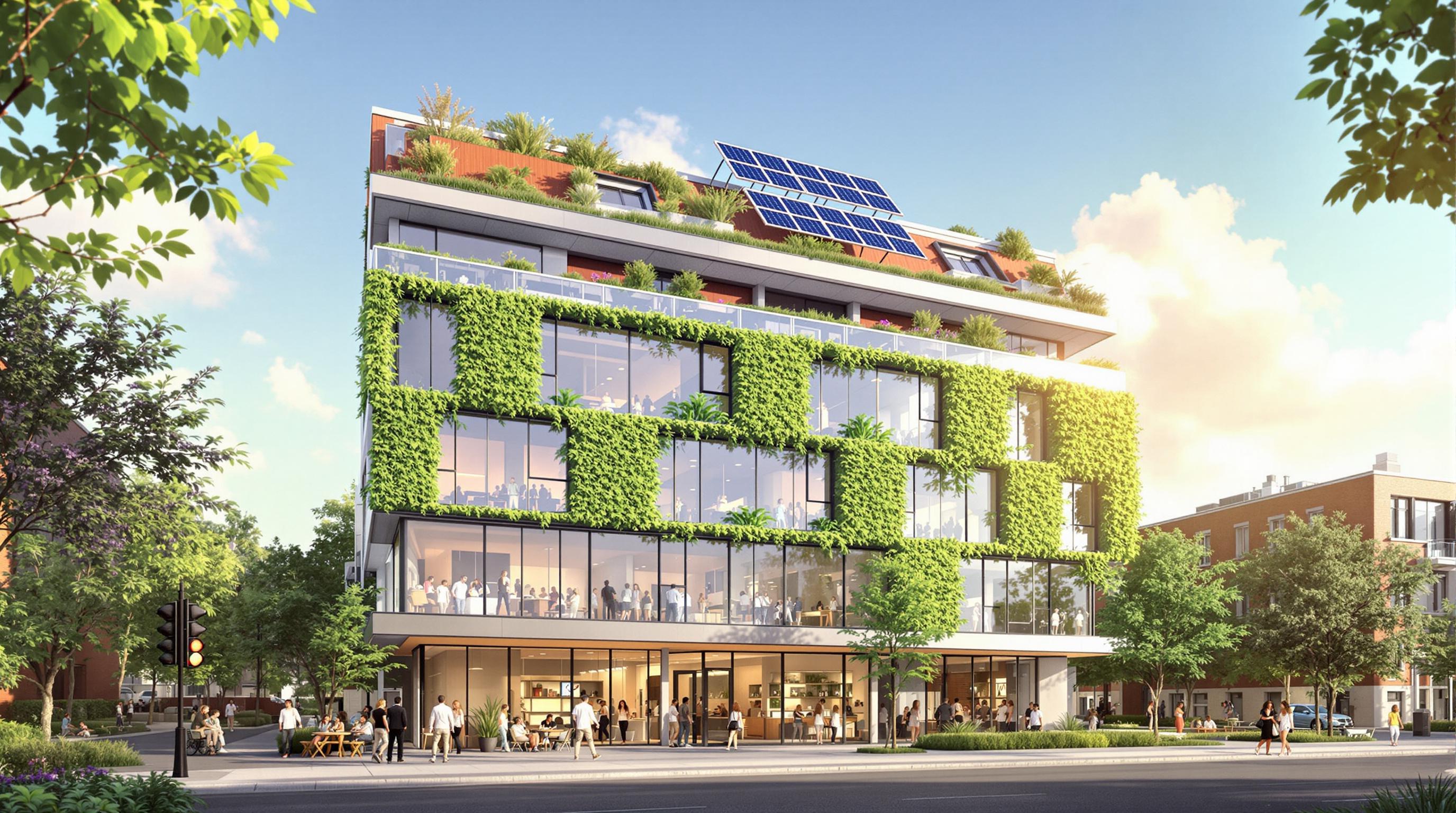Nova Scotia's construction industry is shaped heavily by its seasons, with housing starts up 184.3% since February 2023. Seasonal weather impacts everything from project timelines to costs, requiring builders to adapt. Here's what you need to know:
- Climate Impact: Rising temperatures (up to 4.5°C by century's end) and extreme weather, like storms dropping 150 cm of snow, are changing construction practices.
- Seasonal Workflows: Companies like Helio Urban Development follow structured seasonal plans:
- Fall: Foundation work before the ground freezes.
- Winter: Focus on interior systems.
- Spring: Site preparation for moisture and ground conditions.
- Summer: Outdoor construction and new projects.
- Cost Trends: Residential construction costs in Halifax rose 4.5% from Q3 2023 to Q3 2024, and non-residential permits surged 100.2% in September 2024.
- Fixed-Price Models: Helio's $168/sq. ft. fixed-price approach minimizes weather-related delays and cost fluctuations.
Quick Comparison
| Aspect | Fixed-Price Models (Helio) | Traditional Methods |
|---|---|---|
| Cost Predictability | Stable pricing year-round | Seasonal fluctuations |
| Weather Impact | Reduced delays | Prone to disruptions |
| Material Management | Pre-planned orders | Seasonal supply chain issues |
| Timeline | Consistent year-round | Extended during bottlenecks |
Nova Scotia's construction sector is adapting to seasonal challenges with structured planning, weather-resistant materials, and modern techniques. These strategies are vital as climate changes reshape the industry.
As sea level rises, could Nova Scotia become an island?
1. Helio Urban Development's Approach

Helio Urban Development tackles the seasonal challenges of construction with a fixed-price, pre-designed model. Starting at $168 per square foot for single-family homes and small multi-unit properties, this approach streamlines the building process to make the best use of resources year-round.
By focusing on duplex, triplex, and fourplex projects, Helio ensures a steady workflow. This helps the company handle resource limitations during slower seasons and take full advantage of busier periods. It's a strategy that reflects broader industry practices aimed at maintaining consistent operations throughout the year.
Experts in the field back up this method. Keith Sawlor, president of Sawlor Built Homes, explained:
"Once the foundations are in the ground we carry on as though it's a regular job in the middle of summer, we actually have several homes on the go right now" [2]
Duncan Williams, president of the Construction Association of Nova Scotia, added:
"Overall cost and availability of labour are important so you can't really afford to let guys go in the middle of winter. If you can keep working, contractors are going to continue working and keep their best people around" [2]
Here's how Helio structures its construction activities across the seasons:
| Season | Focus Area | Main Activities |
|---|---|---|
| Fall | Foundation Work | Completing foundations before the ground freezes |
| Winter | Interior Work | Concentrating on indoor systems and finishing |
| Spring | Site Preparation | Handling moisture and ground conditions |
| Summer | Exterior Work | Maximizing outdoor construction and starting new projects |
This seasonal plan helps Helio address the challenges of weather and labor availability. It also aligns with Nova Scotia's construction trends, where apartment unit construction has grown significantly - from 600 units annually (2000-2008) to 1,400-1,700 units per year since 2013 [2]. By following this structured process, Helio ensures projects stay on schedule and within budget while maintaining high standards.
sbb-itb-16b8a48
2. Nova Scotia Industry Standards
In Nova Scotia, the construction industry operates within distinct seasonal patterns that affect project timelines, costs, and resource management. For example, total building permits in the province rose by 21.6%, reaching $276.0 million in September 2024. In Halifax, residential construction prices grew by 4.5% from Q3 2023 to Q3 2024, outpacing the national average of 4.1%. Meanwhile, non-residential construction costs increased by 2.1% during the same period [4]. These figures highlight the challenges and opportunities tied to the seasonal nature of the industry.
Maurice Fares, Vice-President of W.M. Fares Group, sheds light on one of the industry's pressing issues:
"Sometimes there's such a high demand for the labour that the labour is ending up on a project with the bare minimum training." [6]
To navigate these challenges, construction companies in Nova Scotia adjust their operations based on the seasons:
- Fall: Infrastructure projects face completion pressures, driving up labor costs.
- Winter: Indoor work takes center stage, with added expenses for heating and weather protection.
- Spring: Site preparation activities ramp up, pushing material costs higher.
- Summer: The peak season for construction, leading to increased demand and higher labor rates.
Recent projects highlight how the industry adapts. The Bayers Lake Community Outpatient Centre, for instance, earned LEED Gold certification in August 2024, showcasing a commitment to environmentally conscious construction despite seasonal hurdles [3]. The commercial sector also saw a surge, with non-residential building permits jumping 100.2% to $107.5 million from August to September 2024 [4]. This growth reflects strong activity in Halifax's commercial and institutional projects.
Seasonal fluctuations also drive up labor and material costs, prompting companies to adopt weather-resistant materials and flexible schedules. Build Nova Scotia's waterfront initiatives, like the Bedford Waterfront Marina pilot project running through mid-November, demonstrate how weather directly impacts timelines [3].
The construction industry in Nova Scotia continues to adapt, finding ways to tackle seasonal challenges while maintaining high productivity and quality standards. These strategies echo the innovative approaches seen in firms like Helio Urban Development.
Benefits and Limitations
The seasonal nature of construction in Nova Scotia comes with its own set of advantages and challenges. To better understand these, let’s compare fixed-price, pre-designed models - like those from Helio Urban Development - with more traditional construction methods:
| Aspect | Helio Urban Development | Traditional Industry Practices |
|---|---|---|
| Cost Predictability | Fixed pricing at $168/sq. ft ensures costs remain stable, regardless of seasonal changes | Prices fluctuate with labor availability and material costs throughout the year |
| Weather Impact | Streamlined processes reduce weather-related delays | More prone to delays and cost overruns due to bad weather |
| Material Management | Pre-planned orders ensure stable costs | Seasonal supply chain issues can cause price spikes |
| Construction Timeline | Standardized planning keeps projects on track year-round | Seasonal bottlenecks often lead to extended timelines |
This comparison highlights how each approach handles seasonal construction challenges differently.
"Climate is the biggest and most important factor in construction; it's what determines the materials used, the time frame for construction and the durability and longevity of the constructed building." – Casey Heigl, Marketing Manager at Gluegun.com [7]
How Fixed-Price Models Address Seasonal Challenges
Helio Urban Development’s fixed-price approach tackles seasonal issues with strategies like:
- Material Selection: Using weather-resistant materials suited to Nova Scotia's climate.
- Schedule Optimization: Streamlined processes reduce disruptions caused by seasonal changes.
- Cost Control: Fixed pricing protects projects from market fluctuations.
Advantages of Traditional Methods
On the other hand, traditional construction methods bring:
- Design Flexibility: Custom designs tailored to specific seasonal needs.
- Local Expertise: Leveraging deep knowledge of regional weather patterns.
- Resource Scaling: Adjusting workforce deployment based on seasonal demand.
These differences explain why some developers prefer fixed-price models, while others stick with traditional methods to address seasonal variations.
Helio Urban Development’s structured, fixed-price model minimizes risks posed by extreme weather, offering a consistent solution. Meanwhile, traditional methods shine in milder conditions, where customized designs and regional adaptability are key [5].
Conclusion
The construction industry in Nova Scotia is showing resilience, with Halifax housing starts surging by an impressive 361.8% in February 2024 compared to the prior year [1].
At the same time, climate trends are reshaping the region. Nova Scotia has been losing about 7 winter days annually over the past decade. Coastal areas like Digby, Yarmouth, and Shelburne are seeing more above-freezing days [8]. These changes affect construction timelines and push for shifts in investment strategies.
"In Canada's Maritime regions, winter is changing." - Kristina Dahl, Climate Scientist [8]
In January 2024, building construction investment rose by 28% year-over-year [1]. With a growing number of commercial, industrial, and institutional projects, the market is adapting to these seasonal shifts through modern construction techniques and climate-aware planning.
To succeed, developers need to focus on climate resilience, smart scheduling, well-timed investments, and effective resource management.
Related Blog Posts
- Green Building Incentives in Halifax: How Eco-Friendly Construction Boosts ROI
- Mortgage Bonds & Central Bank Liquidity: Impact on Nova Scotia Housing Costs
- Demographic Tides: Analyzing Youth Migration & Retirement Inflow in Nova Scotia’s Housing Market
- Going Net-Zero: Designing Sustainable Multi-Units in HRM for Long-Term Savings



